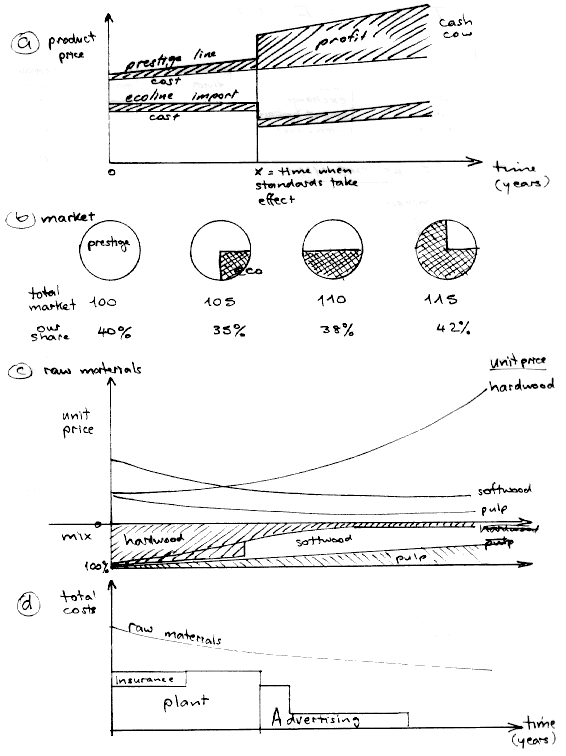Trouble at the Mill
Contents
- The Case
- Nouns and Mind Map 1
- Text with Analysis, Vocabulary and Grammar
- Nouns and Adjectives and Mind Map 2
- Changes and Relationships
- Changes in Nouns and Adjectives
- Changes in Relationships
- Verbs and Adverbs
- Strategies
- Further Exercises
1. The Case
|
Trouble at the Mill
Bowing to environmentalists' demands could drive a paper maker to extinction.
Dilemma
Eco-friendly plant is expensive, and the environmental manager's position
on the board is weak.
The letter from the environmental pressure group leaves no room for
doubt: it is threatening to cause the Venlo Paper Company a lot of unspecified
trouble unless immediate steps are taken to use recycled pulp in its paper
manufacture, and to stop using chlorine to bleach it.
Martyn Lievaart, manager responsible for environmental affairs, stares
at it in horror: he has only just been promoted to the management board,
and does not yet feel his colleagues' support to be strong enough to face
a challenge of this size.
The company has made high-quality writing and business papers in the
southern Dutch town for more than 80 years. It has a reputation for
making prestige products, but in truth, margins are slim and the paper
mill, although reasonably modern, is below the standards now imposed upon
such operations by the Dutch government and the European Commission.
The management board is not insensitive to the environmentalists' demands
- as Lievaart's appointment suggests. The company has tried to conform
to leglislation and buy its pulp from sustainable sources in North America,
but the quality required cannot be achieved with ordinary recycled pulp
using its existing equipment. Meanwhile, public pressure is growing for
the industry to use more of the paper waste being collected for recycling,
and to clean up its effluent.
At the moment, as Lievaart is aware, Venlo has no chance of being awarded
am 'eco-label' for its stationery, and sales are starting to suffer as
a result.
The investment in plant that will enable recycled pulp to be used for
high-quality papers and the bleaching process to be modified will, he calculates,
amount to more than FL 3 milion (ECU 1.4 million) - at least two years'
profits, with no additional turnover. Lievaart's colleagues on the
board are mostly traditional paper makers, whose long experience of the
struggle to survive commercially has given them a robust view of investment,
pressure groups, public opinion - and of enthusiastic young environmental
managers.
He knows that if he tries to push his colleagues too hard, particularly
in a recession, he risks hardening their attitudes to the environmental
issue and, indeed, to his job. On the other hand, he realizes the
letter is a straw in the wind of public opinion. If the company does nothing,
sales, and its reputation, will be damaged, and the gradual tightening
of regulations will in the end threaten its very existence. Meanwhile,
what to do about that letter?
| |
2. Nouns and Mind Map 1
Make a list of all the objects discussed in the case. This can be
done during the reading, beginning with the main persons, the organisational
units and physical objects. Later the minor participants and abstract
objects can be added, perhaps during discussion.
|
These items can be placed and linked together on the mind map.
Note that some items have been (intentionally) forgotten, and the
diagram will be further improved.
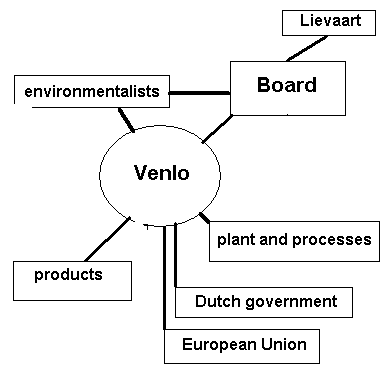
|
The same information can be presented in list form, nesting with sublists.
But keep just one "latest" version - throw away each previous version when
you have taken all its information.
the environmentalists
the board - Lievaart and his colleagues
the resources
hard wood
soft wood
recycled paper
the plant and processes
the Dutch government
the European Union
the products
|
At any time you can add more points and rearrange - but paper is
more flexible. Some editors can deal with lists - for instance in Power Point -
but there are always problems with items which belong in two or more locations,
and when you want to make links between items
the plant and processes
the bleaching
chlorine
no bleach
the effluent
|
|
|
Pencil and paper is by far the most user-friendly tool!
The map above was created using a simple graphic editor -
which has an range of shapes (ellipses and rectangles), lines, arrows, and colors.
There are some powerful features - such as boxes containing boxes -
and the diagram can be imported into word-processors.
Limitations, for instance on rotation and curved lines, can be overcome
using more advanced graphic tools sich as flowcharters and presentation graphics
packages.
3. Text with Analysis, Vocabulary and Grammar
The main difficulty with this text is that sentences are long and complex.
The method of sentence decomposition can be used to help. Pay special
attention to the roles of conjunctions such as unless, or,
and, if [then], and but and the use of colons
: and dashes - to split sentences.
| Trouble at Mill |
|
|
| Bowing to environmentalists' demands could
drive a paper maker to extinction. |
to bow down
to drive them to extinction - to lead to death - to force
a collapse |
|
| Dilemma |
|
|
| Eco-friendly plant is expensive, and the
environmental manager's position on the board
is weak. |
plant - equipment in a factory
eco - ecology |
|
| The letter from the environmental pressure
group leaves no room for doubt:
it is threatening to cause the Venlo
Paper Company a lot of unspecified
trouble unless immediate steps
are taken to use recycled pulp in its paper
manufacture, and to stop using chlorine
to bleach it. |
no room for doubt
unspecified - not stated
pulp - the flesh of a plant
manufacture - the process of fabrication |
The letter leaves no doubt.
The group threatens to cause trouble,
unless steps are taken.
Steps are to use ... and to stop ... |
| Martyn Lievaart, manager
responsible for environmental affairs, stares
at it in horror:
he has only just been promoted to the management
board, and does not yet feel his colleagues'
support to be strong enough to face a challenge
of this size. |
affairs - business
to stare in horror - to look at with dismay
to be promoted - to get a better job
strong enough -
of this size . as big as this
|
Lievaart stares at what in horror?
Lievaart has recently ?
Lievart thinks his colleagues will not support him strongly
enough. |
| The company has made high-quality writing
and business papers in the southern Dutch
town for more than 80 years.
It has a reputation for making prestige products,
but in truth, margins
are slim and the paper mill, although reasonably
modern, is below the standards [which
are] now imposed upon such operations by the
Dutch government and the European
Commission. |
high-quality
writing papers
business papers
prestige products
in truth - in reality - really
margins are slim
reasonably - moderately
to be below standard
to impose - to enforce |
Are the business papers also of high quality?
a reasonably modern mill
What does 'reasonably' describe? What sort of word
is it? |
| The management board is not insensitive
to the environmentalists' demands - as Lievaart's
appointment suggests. The company
has tried to conform to leglislation and buy
its pulp from sustainable sources
in North America, but the quality
required cannot be achieved with ordinary recycled pulp
using its existing equipment. Meanwhile, public
pressure is growing for the industry
to use more of the paper waste [which
is] being collected for recycling, and to
clean up its effluent. |
not insensitive = sensitive
to conform to legslation - to obey the law
sustainable - able to be continued or maintained
the quality required - the needed standard
ordinary - common - usual
pressure is growing - the ? is increasing
effluent - outflowing waste water |
double negative makes a positive
Why is the ' sometimes before and sometimes following
the 's'
environmentalists' Lievaart's |
| At the moment, as Lievaart
is aware, Venlo has no chance
of being awarded an 'eco-label' for its stationery,
and sales are starting to suffer as a result. |
at the moment - now
no chance
'eco-label' - a certification that a product is environmentally
safe |
to be awarded
sales are starting to suffer |
| The investment in plant
that will enable recycled pulp to be used
for high-quality papers and the bleaching
process to be modified will, he calculates,
amount to more than FL
3 million (ECU 1.4 million) - at least two
years' profits, with no additional turnover.
Lievaart's colleagues on the board
are mostly traditional paper makers, whose
long experience of the struggle
to survive commercially has given them a robust
view of investment,
pressure groups, public opinion
- and of enthusiastic young environmental managers. |
to enable - to permit - to allow
recycled pulp
high-quality papers
bleaching process
turnover
the struggle to survive - the effort to live
a robust view - strong and stable - their minds are not
easily changed
pressure group - lobby |
The investment in X will amount to Y
X=plant that will enable A and B
Y=more than ... = at least ...
Identify the passive verbs:
to be used, to be modified
|
| He knows that if he
tries to push his colleagues too hard, particularly
in a recession, he risks hardening their attitudes
to the environmental issue and, indeed, to
his job. On the other hand, he realizes
the letter is a straw
in the wind of public opinion.
If the company does nothing,
sales, and its reputation,
will be damaged, and the gradual tightening
of regulations will in the end threaten its
very existence. Meanwhile, what [is]
[there] to do about that letter? |
to push someone
to harden - to make hard
indeed - in fact
a straw in the wind
tightening of regulations - enforcing the law
to threaten its existence - to challenge its survival |
Lievart knows what?
If he pushes too hard, he risks A and B
What to do about that letter. Rewrite as
a proper sentence.
What should he do about that letter?
What can be done about that letter? |
4. Nouns and Adjectives and Mind Map 2
The next step is to expand this list and the initial mind map to include
all characteristics which are mentioned for each object.
The major
advantage of the Mind Map is that it does not matter where in the text
it occurs - each characteristic (attribute, description) can be placed
in an appropriate place.
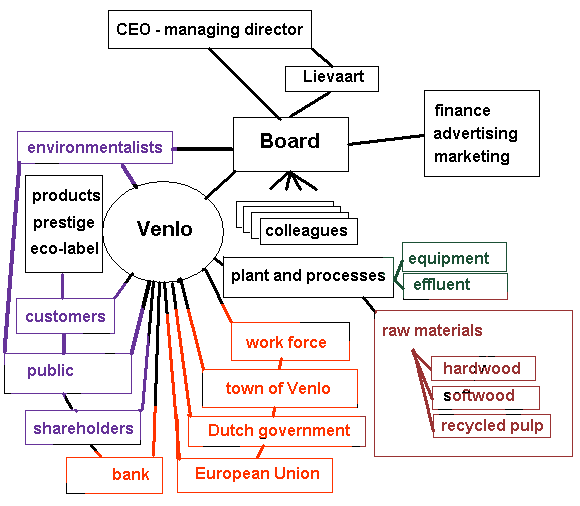
All the characterics can be placed on the mind-map.
The following list is given to show an alternative presentation.
object characteristic
------ --------------
the business environment in recession
the public opinion, winds of change
an environmental pressure group sent the letter
the Dutch government standards, eco-label
the European commission regulations
the products
writing and business stationery prestige, high quality, demand reducing
prices / costs low margins
the mill and the process of manufacture
the board
the board's conservatives not easily persuaded
Lievert new position, insecure, weak
finances (money) low margins
plant (equipment) old, unable to handle pulp
effluent (smoke, water) polluting
raw materials (hard,soft,pulp) cost and supply
|
We can add further objects, not explicitly stated in the case study:
object characteristic
------ --------------
the business environment
customers changing market
shareholders interest in profits
the products
alternatives to glossy paper low quality, low price
the factory and process
new equipment requires investment
new raw materials recycled paper, pulp
the work force recession, job insecurity
|
After the Nouns and Adjectives Mind Map has been produced, there should
be a break. It could be as long as a week, during which time solutions
will "suggest themselves" to the participants.
The first part has concentrated on understanding. It has not been
creative, since the aim was to represent the
existing text in another form and not to add anything. The group
work included a process of discovery and
organisation, as information from the text was brought into the mind-map
representation.
For the next stage, the mind map could be redrawn in a better format.
However, be careful that nothing new is added and nothing is taken away.
Participants who use it at the beginning of the next meeting should have
confidence that they know what is on it.
At the beginning of the next session, presentations can be made
which describe the existing knowledge about the case.
5. Changes and Relationships
We now start the creative phase. We want to find out that possibilities
there are to change the situation. This is a brainstorming step,
we want to gather and create alternatives and we do not judge them.
Cost, effectiveness, feasibility etc are not to be considered yet.
We first start with the Nouns - the actors, objects and abstracts.
We already identified new Nouns: some like the customers and alternative products which
have been mentioned indirectly, and others like the workforce or Venlo shareholders
which have not been mentioned but which could take an important role depending on the actions
which we will decide to take.
6. Changes in Nouns and Adjectives
We go through all Nouns and see how we can change any of their Adjectives.
- Lienert - how do we make him stronger and feel more secure, to allow him to propose difficult choices?
- How do we influence the public and our customers - though advertising?
- Products - we can introduce an 'eco' product
- Processes - we have to upgrade plant and reduce pollution
|
7. Changes in Relationships
The "relationships" phase uses a simple and logical way to analyse the situation
and the possibilities for change. We look first at combinations of
the Nons in the case and describe the linkage or type of relationship between them.
- 1. regulations will force the company to change
- 2. public attitudes will hurt sales since there is no ecolabel
- 3. actions threatened by pressure group will damage the factory
- 4. public attitudes will change government attitudes
- 5. lower profits and lower sales will hurt the company
- 6. company needs investment for new plant
- 7. some decisions will make Lievert more insecure
|
then we look to see how we can influence the relationship.
8. Verbs and Adverbs
We can work out the points where we can make a change. This is to be discussed in a
brainstorming session. The results are to be listed in a proposal, and presented in a
simulation of a "meeting of the board."
Results of some sessions on this case are in graphic form and in a list.
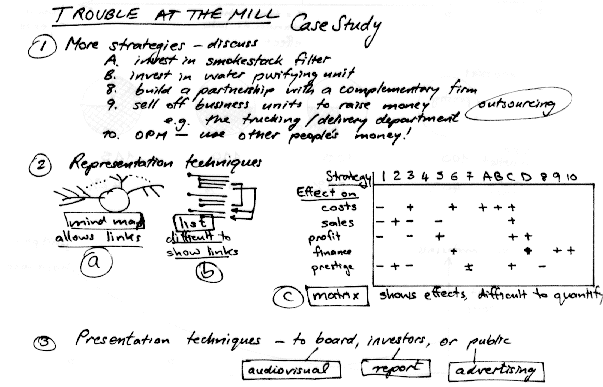
In list format:
- A. effluent cleanup (smoke and water) or none
- B. change from chlorine bleach to something safer (peroxide, oxygen)
- C. change raw materials from hard wood to soft wood or recycled paper (change the mix)
- D. develop new,"eco-label" products - even by importing them!
|
9. Strategies
Then we work out how and when to cause a desirable changes in each relationship.
- 1. get the government help,to avoid meeting standards
- 2. inform the public about costs of a change in moneyand jobs lost
- 3. get extra insurance and security protection
- 4. no chance! - you can┤t swim against the stream
- 5. raise prices for the prestige products because of environmental damage
- 5. market the new ecolabel products at a higher price
- 6. ask the government or E.C. for investment money
- 6. ask the public to raise money for the change (loan, bonds)
- 7. get public backing for Lievert against the board
- A. get investment to change cleanup process
- B. get investment to change bleaching process
- C. Ask for public support to recycle paper at low cost
- C. Ask for government help to reduce imports
- D. Generate lots of support through advertising publicity
|
In order to pesuade the board,
to counter the opposition of the conservative members,
Lievaart may have to make a special effort:
- convince the board of the power of public opinion
- make them ecologically-minded
- get figures of change in market share under various scenarios
- propose financing alternatives
- compare with competitors
- propose an advertising campaign
|
The strategy should be presented in a
simulation of a meeting of the Board.
It can be written out in the form of a memo.
10. Further Exercises
The group may want to work further on the case. This occurred when we
had several accounting - manager types in the group!
- More detail is needed
- Prices of Raw Materials
- Usage of raw materials
- Market share
- Income Figures
- Plant and Process costs
- Results
|
The results should be presented to the Board.
More detail is needed
We need figures! We want to relate strategies to costs and profits.
The results are presented in the following diagrams, then the method of reaching them.
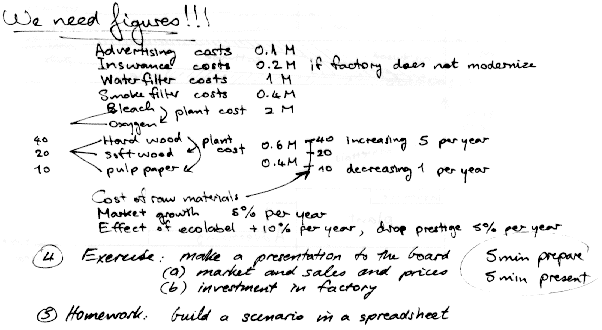
Prices of Raw Materials
We set the prices as follows: Hardwood increases from $80 a ton by
5% each year, softwood remains constant and recycled reduces at 5% per year.
We aim to change the mix of hard and soft wood for the prestige products
to have 50-50 in five years, and with the new plant we begin using an equivalent
amount of recycled material after three years.
We begin selling eco-label products now using imported paper and replace
this by our own after three years.
A B C D E F G H I J K
4 1995 1996 1997 1998 1999 2000
5 Raw Materials
6 price 105% Hardwood $80 $84 $88 $93 $97 $102 $B6*I6
7 100% Softwood $60 $60 $60 $60 $60 $60 $B7*I7
8 95% Recycled $40 $38 $36 $34 $33 $31 $B8*I8
9 usage Hard prestige 100% 90% 80% 60% 50% 40%
10 Soft prestige 10% 20% 40% 50% 60%
11 Recycle ecolabel 0% 100% 100% 100%
12 cost Hard prestige $80 $76 $71 $56 $49 $41 J9*J6
13 Soft prestige $0 $6 $12 $24 $30 $36 J19*J7
14 Recycle ecolabel $0 $0 $0 $34 $33 $31 J11*J8
15 Total prestige $80 $82 $83 $80 $79 $77 J12+J13
16 Total $35 ecolabel $35 $35 $35 $34 $33 $31 $35ŽJ14
|
The prices of the raw materials are shown in the following diagram.
This was an exercise with a spreadsheet program
and business graphics - a useful practice for business presentations.

Usage of raw materials
This diagram is also derived from the above figures.

Market share
We assume that the absolute market for prestige paper is declining at 5 % each year
and the market for eco products is growing at 20%. We have most of the prestige market
and we wish to take half of the eco market from 1998.
The formula in column K gives the equation used to calculate the previous cell.
A B C D E F G H I J K
4 1995 1996 1997 1998 1999 2000
18 Sales
19 Market 95% prestige 800 760 722 686 652 619 $B19*I19
20 120% ecolabel 200 240 288 346 415 498 $B20*I20
21 total 1000 1000 1010 1032 1066 1117 J19+J20
22 Venlo 90% prestige 720 684 650 617 586 557 $B22*J19
23 share 20% ecolabel 40 48 58 69 83 100 $B23*J20
24 50% ecolabel 100 120 144 173 207 249 $B24*J20
25 est.* ecolabel 40 48 58 173 207 249 J23ŽJ24
|

Income Figures
In the following model we keep the sales price constant and subtract
the cost of the raw material (which we assume reflects the processing costs)
to give the margin figures.
A B C D E F G H I J K
4 1995 1996 1997 1998 1999 2000
26 Price 100% prestige $100 $100 $100 $100 $100 $100 $B26*I26
27 100% ecolabel $40 $40 $40 $40 $40 $40 $B27*I27
28 Raw Materials prestige $80 $82 $83 $80 $79 $77 J15
29 ecolabel $35 $35 $35 $34 $33 $31 J16
30 Margin prestige $20 $18 $17 $20 $21 $23 J26-J28
31 ecolabel $5 $5 $5 $6 $7 $9 J27-J29
32 Income prestige $14400 $12586 $11333 $12614 $12538 $12902 J30*J22
33 ecolabel $200 $240 $288 $986 $1539 $2252 J31*J25
34 Total $14600 $12826 $11621 $13600 $14077 $15154 J32+J33
|

Plant and Process costs
We have not gone into detail here, apart from setting a fixed price on
plant replacement. Decision of the group was that we will not
invest in water filtration, but that wee need to clean the smoke
and will do this at a cost of $400,000 in the year 2000.
Until we have the new chlorine-free production running in 1998, which will cost $2,000,000,
we have to process the pulp specially.
The team became impatient with the details and decided that we must also consider
insurance for the possible activities of the environmentalist pressure group
security costs to protect the mill until the new plant is running
advertising
fines from government for non-processing of industrial waste
The fines would according to the new law be in the form of purchase of "pollution credits",
which can be purchased on the stock market. In fact, we already plan to hedge
in this market by purchasing future optionos.
A B C D E F G H I J K
4 1995 1996 1997 1998 1999 2000
35 Additional Costs
36 Advertising prestige $100 $500 $300 $1,000 $700 $300
37 Security $100 $100 $100 $50 $50 $50
38 Insurance $200 $200 $200 $0 $0 $0
39 Fines/pollution credits $60 $40 $20 $20 $20 $0
41 Plant water filter never
42 smoke filter in 2000 $400
43 new bleach in 1997 $2,000
44 pulp handling $600 $400
45 Running costs $12000 $11000 $10000 $10000 $10000 $10000
46 Total $13060 $12240 $12620 $11070 $10770 $10750 J37:J45
47
48 Profit $1540 $586 ($999) $2530 $3307 $4404 J34-J46
|
The original spreadsheets may be examined,
for instance to see the effects of changing
parameters: venlo1 and venlo2
